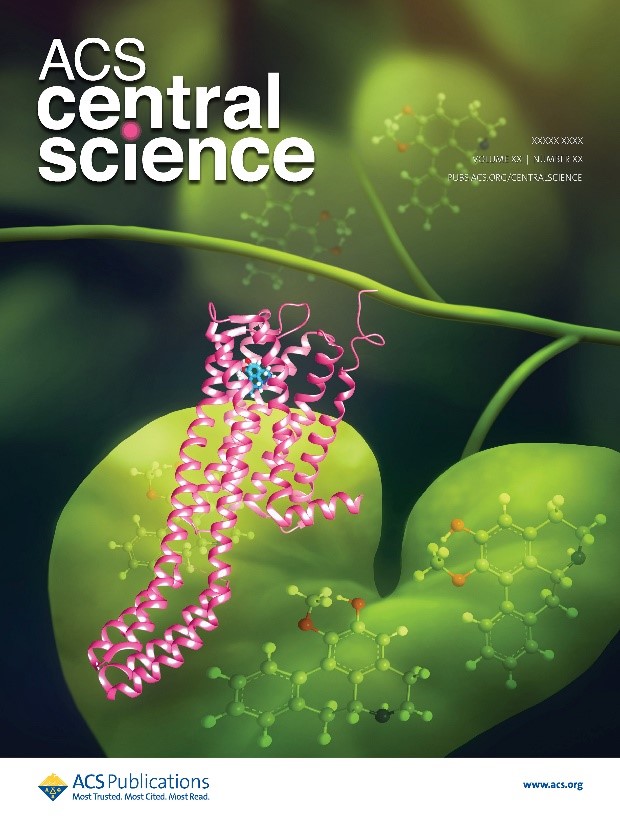Recently, Prof. Shui Wenqing’s group from iHuman Institute and SLST has made a breakthrough in bioactive screening from herbal extracts. Based on their previous work in developing the affinity mass spectrometry (MS) technique for ligand screening (Chemical Science 2018, Analytical Chemistry 2019), they combined affinity MS-based screening with compound isolation and pharmacological study to identify a novel subtype selective agonist Asimilobine (1857) for 5-HT2C receptor from herbal extracts. This work was published in ACS Central Science on February 26th of 2020, entitled “A Novel G Protein-Biased and Subtype-Selective Agonist for a G protein-Coupled Receptor Discovered from Screening Herbal Extracts” and was selected as a supplementary cover image (Figure 1).
G protein-coupled receptors (GPCRs) represent the largest membrane protein family which comprises a number of highly valued drug targets involved in a wide range of physiological activities. 5-HT2C receptor belongs to GPCR class A family, which is mainly distributed in the central nervous system and plays an important role in mode regulation, appetite, memory, cognition and energy metabolism. Recently, 5-HT2C receptor has been recognized as a potential drug target for obesity, epilepsy, schizophrenia and drug abuse. The FDA-approved drug lorcaserin is a 5-HT2C selective agonist which can reduce body weight through food intake suppression. However, developing subtype selective agonists for 5-HT2C receptor is a considerable challenge owing to the highly conserved ligand-binding pockets among serotonin receptors.
Having diverse chemical structures and distinct bioactivities, natural products is an important and unique source in drug discovery. However, traditional methods for the isolation and identification of natural product monomers are mostly labor-intensive and cost-prohibitive, and meanwhile, some factors like activity screening and function evaluation depending on monomer purity can limit the medicinal development of natural products.

Figure 1. The supplementary cover image. (Designed by Julie Liu)
Shui’s group has established an efficient affinity MS-based workflow for GPCR ligand discovery from natural herbs to overcome the limitations of traditional screening methods. In this work, the researchers first assayed bioactivities of crude extracts from 15 different herbs using a calcium flux assay at 5-HT2 subfamily members.They picked up three herbal extracts with the highest potency which are Stephania tetrandra (ST), Aristolochia debilis (AD) and Tetradium ruticarpum (TR) for subsequent affinity MS screening. Using the affinity MS technique, the researchers rapidly identified serotonin and its analogue 5-methoxy-N, N-dimethyltryptamine (5-MeO-DMT) as the dominant bioactive components in the AD and TR crude extracts. Therefore, these two herbs were abandoned for further experiments. Notably, a cluster of aporphine alkaloids were identified from the ST extract by affinity MS screening and then a novel agonist 1857 was isolated from the total extract guided by LC-HRMS data (Figure 2). Intriguingly, the agonist 1857 showed exquisite subtype selectivity for 5-HT2C receptor in Gq-mediated calcium signaling. Furthermore, this novel ligand exhibited exclusive bias towards G protein signaling for which key residues were identified by molecular docking and mutagenesis. More importantly, 1857 showed comparable in vivo efficacy for food intake suppression and weight loss as the anti-obesity drug, lorcaserin.

Figure 2. The workflow of affinity MS-based 5-HT2C ligand screening from natural product extracts.
In summary, this study establishes an efficient approach to discovering novel GPCR ligands by exploring the largely untapped chemical space of natural products. The approach eliminates the need for pure compound isolation at the initial screening phase to significantly improve the screening efficiency. Moreover, 1857 is the first aporphine displaying exclusive biased G protein agonism at 5-HT2C with strong selectivity over 5-HT2A and 5-HT2B. The unique pharmacological profile of 1857 leads to a new avenue for design of potent and functionally selective 5-HT2C agonists.
Postdoc Dr. Zhang Bingjie and Assistant Research Professor Zhao Simeng from iHuman Institute are the co-authors of this publication. Prof. Shui Wenqing and Prof. Zhong Guisheng from iHuman Institute and SLST, and Prof. Wang Mingwei from Shanghai Institute of Materia Medica are corresponding authors. ShanghaiTech University is the first completion unit. This work was supported by startup funding from ShanghaiTech University, National Key R&D Program of China and National Natural Science Foundation of China.
Link of the article: https://pubs.acs.org/doi/10.1021/acscentsci.9b01125

